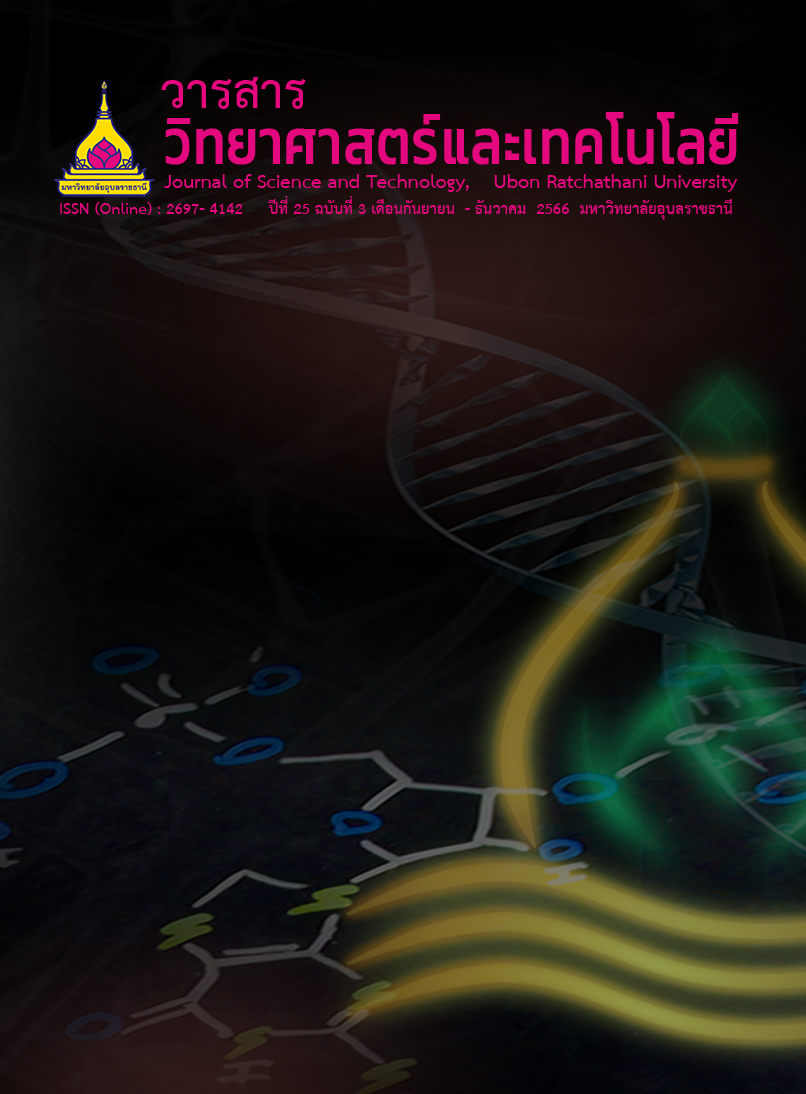การเพาะเห็ดเป๋าฮื้อด้วยขี้เลื่อยไม้กระถินณรงค์ที่เหลือใช้จากอุตสาหกรรมการทำกรงนกเขาชวา
Main Article Content
บทคัดย่อ
กระถิ่นณรงค์เป็นวัตถุดิบที่สำคัญในอุตสาหกรรมการทำกรงนกเขาชวา โดยใช้ทำหัวตะขอกรงนก ซึ่งต้องผ่านการกลึงอย่างประณีต ทำให้เกิดขี้เลื่อยในกระบวนการผลิต งานวิจัยนี้มีวัตถุประสงค์เพื่อศึกษาความเป็นไปได้ในการใช้ขี้เลื่อยไม้กระถินณรงค์ที่เหลือใช้จากการทำกรงนกเขาชวามาเป็นส่วนประกอบของวัสดุเพาะเห็ดเป๋าฮื้อ ในการศึกษานี้ผสมขี้เลื่อยไม้ยางพารากับขี้เลื่อยไม้กระถินณรงค์ในอัตราส่วนที่ต่างกัน (100:0, 75:25, 50:50, 25:100 และ 0:100) แล้วหมักเป็นระยะเวลา 14 วัน ก่อนนำมาอัดใส่ถุงพลาสติกเป็นก้อนวัสดุเพาะเห็ดขนาด 1 กิโลกรัม หลังจากถ่ายหัวเชื้อเห็ดเป๋าฮื้อลงในวัสดุเพาะแล้ว บ่มในที่มืดที่อุณหภูมิห้อง เป็นเวลา 45 วัน เพื่อสังเกตการเจริญของเส้นใยเห็ด ซึ่งพบว่าการเจริญของเส้นใยเห็ดในวัสดุเพาะที่แตกต่างกันไม่มีความแตกต่างกันอย่างมีนัยสำคัญทางสถิติ หลังจากการเปิดดอกเห็ด เก็บดอกเห็ดเป๋าฮื้อที่ระยะเวลา 20, 40 และ 60 วันเพื่อนำมาวิเคราะห์ปริมาณ และคุณภาพของดอกเห็ด ซึ่งพบว่าอัตราส่วนของขี้เลื่อยไม้ยางพารากับขี้เลื่อยไม้กระถินณรงค์ที่แตกต่างกันส่งผลต่อน้ำหนักสดของดอกเห็ด ความกว้างของหมวกดอก ความสูงของดอกเห็ด และความสมบูรณ์ของดอกเห็ด อย่างมีนัยสำคัญทางสถิติ โดยเห็ดเป๋าฮื้อที่เพาะด้วยวัสดุเพาะที่มีอัตราส่วนของขี้เลื่อยไม้ยางพารากับขี้เลื่อยไม้กระถินณรงค์เท่ากับ 50:50 มีน้ำหนักสดของดอกเห็ด ความกว้างของหมวกดอก ความสูงของดอกเห็ด และความสมบูรณ์ของดอกเห็ดสูงสุดในทุกระยะเวลาของการศึกษา งานวิจัยนี้แสดงให้เห็นถึงความเป็นไปได้ในการเพิ่มมูลค่าของขี้เลื่อยไม้กระถินณรงค์ ซึ่งเป็นวัสดุเหลือใช้จากอุตสาหกรรมการทำกรงนกเขาชวา โดยนำมาใช้เป็นส่วนประกอบของวัสดุเพาะเห็ดเป๋าฮื้อ
Article Details

อนุญาตภายใต้เงื่อนไข Creative Commons Attribution-NonCommercial-NoDerivatives 4.0 International License.
บทความที่ได้รับการตีพิมพ์เป็นลิขสิทธิ์ของ วารสารวิทยาศาสตร์และเทคโนโลยี มหาวิทยาลัยอุบลราชธานี
ข้อความที่ปรากฏในบทความแต่ละเรื่องในวารสารวิชาการเล่มนี้เป็นความคิดเห็นส่วนตัวของผู้เขียนแต่ละท่านไม่เกี่ยวข้องกับมหาวิทยาลัยอุบลราชธานี และคณาจารย์ท่านอื่นๆในมหาวิทยาลัยฯ แต่อย่างใด ความรับผิดชอบองค์ประกอบทั้งหมดของบทความแต่ละเรื่องเป็นของผู้เขียนแต่ละท่าน หากมีความผิดพลาดใดๆ ผู้เขียนแต่ละท่านจะรับผิดชอบบทความของตนเองแต่ผู้เดียว
เอกสารอ้างอิง
Maslin, B.R. 2015. Synoptic overview of Acacia sensu lato (Leguminosae: Mimosoideae) in East and Southeast Asia. The Gardens’ Bulletin Singapore. 67(1): 231-250.
Petchrat, J. and Eddy, S.P.T. 1994. An Economic Analysis of the Bird-Cage Industry in Chana District, Songkhla Province. Songkhla: Prince of Songkla University. (in Thai)
Sripheuk, P. 2007. Use of spent mushroom compost in a cultivation of abalone mushroom (Pleurotus abalonus Han, Chen et Cheng) and Jew’s ear mushroom (Auricularia polytricha (Mont.) Sacc.) in plastic bags. Khon Kaen Agriculture Journal. 35(3): 356-363. (in Thai)
Kongkaew, T. and Wattanakosol, A. 2021. Profit alternative material: The Manila grass ratio of oyster mushroom (Pleurotus ostreatus) cultivated materials. Journal of Science and Technology, Ubon Ratchathani University. 23(2): 74-80. (in Thai)
Anantasaran, J. 2021. Auricularia auricula and Pleurotus ostreatus culture by Acacia auriculiformis sawdust of Java dove’s birdcage waste. Rajamangala University of Technology Tawan-ok Research Journal. 14(2): 47-55 (in Thai)
Ibrahim, H. and et al. 2015. Potential of earleaf acacia (Acacia auriculiformis) leaves for industrial raw materials. International Journal of Scientific Engineering and Applied Science. 1(4): 462-467.
Saffian, H.A. and et al. 2014. Influence of planting density on the fiber morphology and chemical composition of a new latex-timber clone tree of rubberwood (Hevea brasiliensis Muell. Arg.). BioResources. 9(2): 2593-2608.
Abeer, H. and et al. 2013. Biochemical composition of Pleurotus ostreatus (Jacq.) P. Kumm. grown on sawdust of Leucaena leucocephala (Lam.) De Wit. Pakistan Journal of Botany. 45(4): 1197-1201.
Riyaphan, J. and et al. 2015. Variability in chemical and mechanical properties of pará rubber (Hevea brasiliensis) trees. Scienceasia. 41: 251-258.
Matjuskova, N. and et al. 2017. Effect of lignin-containing media on growth of medicinal mushroom Lentinula edodes. Proceedings of the Latvian Academy of Sciences, Section B. 71(1/2): 38-42.
Bonner, C. 2021. The Effect of Lignin Content on the Growth and Yield of Two Specialty Mushroom Species: Pleurotus ostreatus and Hericium erinaceus. M.Sc. Thesis, University of Arizona.
Hoa, H.T. and Wang, C.L 2015. The effects of temperature and nutritional conditions on mycelium growth of two oyster mushrooms (Pleurotus ostreatus and Pleurotus cystidiosus) Mycobiology. 43(1): 14-23.
Iqbal, S.M., Rauf, C.A. and Sheikh, M.I. 2005. Yield performance of oyster mushroom on different substrates. International Journal of Agriculture and Biology. 7(6): 900-903.
Chang, S. 2009. Overview of Mushroom Cultivation and Utilization as Functional Foods. Hoboken: John Wiley & Sons, Inc.
Ponmurugan, P., Sekhar, Y.N. and Sreesakthi, T.R. 2007. Effect of various substrates on the growth and quality of mushrooms. Pakistan Journal of Biological Sciences. 10(1): 171-173.
Stamets, P. 2005. Mycelium Running: How Mushroom Can Help Save the World. Berkeley: Ten Speed Press.
Hassan, S., Mohammad, A.Y. and Kiramat, K. 2011. Cultivation of the oyster mushroom (Pleurotus ostreatus (Jacq.) P. Kumm.) in two different agroecological zones of Pakistan. African Journal of Biotechnology. 10(2): 183-188.
Zhou, G. and Parawira, W. 2022. The effect of different substrates found in Zimbabwe on the growth and yield of oyster mushroom Pleurotus Ostreatus. Southern Africa Journal of Education, Science and Technology. 5(2): 73-86.
Kimenju, J.W. and et al. 2009. Suitability of locally available substrates for oyster mushroom (Pleurotus ostreatus) cultivation in Kenya. Asian Journal of Plant Science. 8: 510-514.
Khare, K.B. and et al. 2010. Production of two oyster mushrooms, Pleurotus sajor-caju and P. florida on supplemented and un-supplemented substrates. Botswana Journal of Agriculture and Applied Sciences. 6: 4-11.
Narain, R. and et al. 2009. Influence of different nitrogen rich supplements during cultivation of Pleurotus florida on maize cobs substrate. Environmentalist. 29: 1-7.
Ceccon, E., Sanchez, I. and Powers, J.S. 2015. Biological potential of four indigenous tree species from seasonally dry tropical forest for soil restoration. Agroforestry Systems. 89(3): 455–467.


